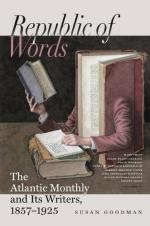Among the articles upon which its success and reputation will chiefly rest are those relating to technology. With scarcely an exception, they are plain, practical, and full of common sense. Those on “Cotton” and “Wool” and their manufactures, the various metals and the ways of working them, (the article on “Zinc” is the best we have ever seen on that subject,) “Gas,” “Ship,” “Railroad,” “Telegraph,” “Sewing-Machine,” “Steam,” and “Sugar,” are compact summaries of valuable knowledge, and will go far to commend the work to a class of persons who, except in our own country, are not much given to reading or book-buying. They vindicate the claims of the Cyclopaedia to be a popular dictionary, not intended solely for the scholar’s library, but directed to the wants of the artisan and man of business. It is not too much to say of many of them,—of “Ship,” for instance, and “Telegraph,”—that, apart from their value as records of industrial progress and invention, they are interesting enough to furnish a very pleasant hour’s occupation to the desultory reader.
The other scientific articles are mostly written in a clear, unpretending style, with a sparing use of technical expressions; and so far as we have discovered, they do ample justice to all recent discoveries. The articles by Professor Bache on the “Tides,” Professor Dalton on “Embryology,” Professor J.D. Dana on “Crystallography,” Dr. W.H. Draper on the “Nervous System,” Professor James Hall on “Palaeontology,” Professor Henry, of the Smithsonian Institution, on “Magnetism” and “Meteorology,” James T. Hodge on “Earth” and “Electricity,” Frank H. Storer on “Chemistry” and kindred subjects, Dr. Reuben on “Heat,” “Light,” “Vision,” “Winds,” etc., and the philological contributions of Dr. Kraitsir and Professor Whitney, do the highest credit to the work in which they appear. The forbidding appearance of Dr. Kraitsir’s articles will get more notice than their deep learning. We cannot but regret that such valuable papers as those on “Hieroglyphics,” “Cuneiform Inscriptions,” “Indian Languages,” and we may add, though belonging to another class of subjects, “Brahma” and “Buddha,” by the same author, should not have been dressed with a little more taste, and the naked deformity of barbarous paradigms covered with some of the ornaments of a readable style. It is the more a pity, because the articles are well worth any care that could be spent upon them.
The biographical articles are sufficiently numerous, and, though rigidly condensed, are full enough for all ordinary purposes. There are few such elaborate biographies as those contributed by Macaulay, De Quincey, and others, to the “Encyclopaedia Britannica”; but Mr. Bancroft’s “Jonathan Edwards,” Mr. Everett’s “Hallam,” “Washington,” and “Daniel Webster,” President Felton’s “Agassiz,” Professor Lowell’s “Dante,” Professor Schaff’s “Luther” and “Melancthon,” Mr. Seward’s “DeWitt Clinton,” A. W. Thayer’s “Beethoven,”




